Luisa Capetillo, cuchillo en boca
Teresa Hernández
Luisa Capetillo, cuchillo en boca
Teresa Hernández
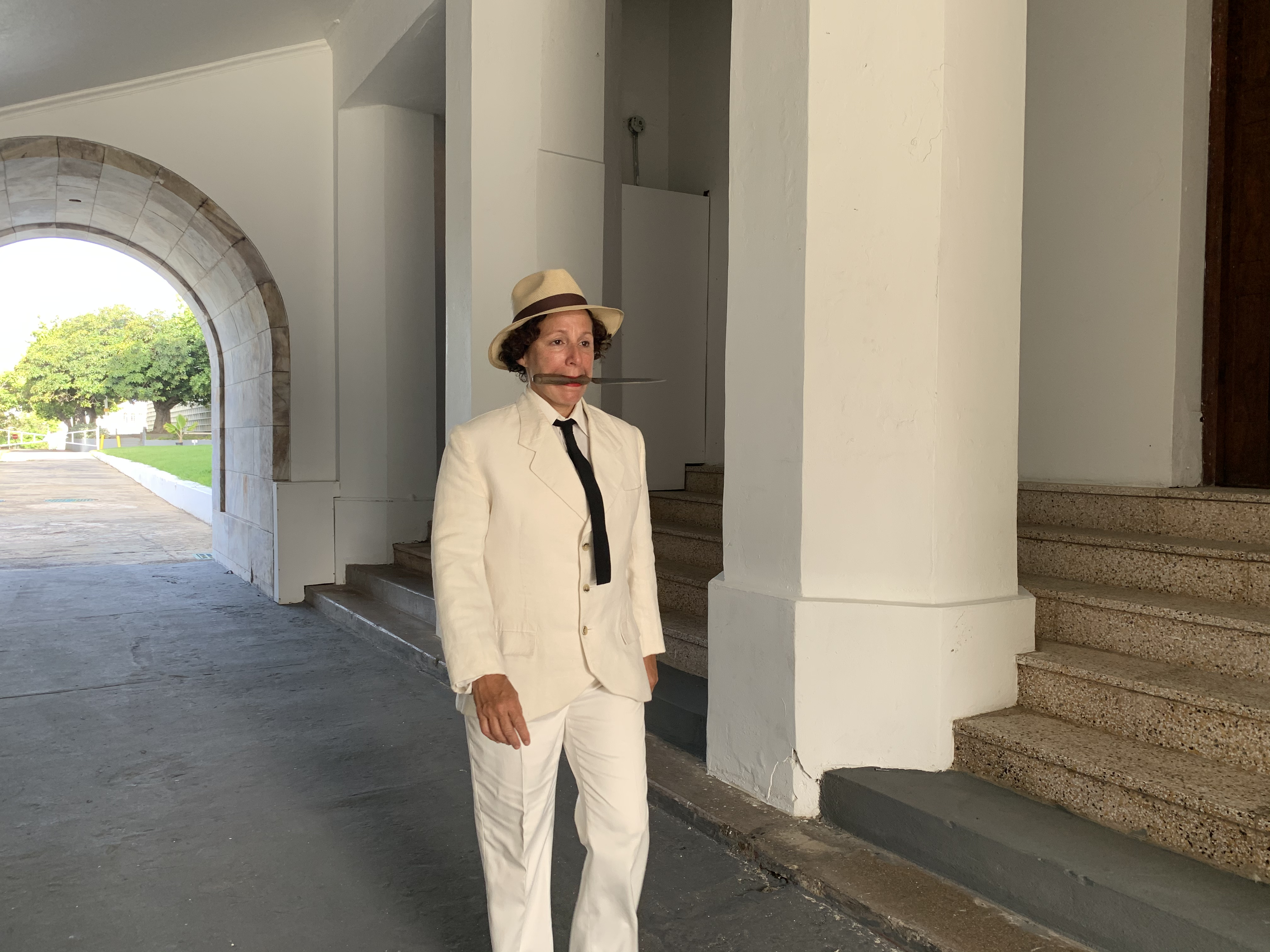
Cover image: Walking Luisa. Capitolio. South Wing, San Juan. Photo by Marisol Plard Narváez. July-August 2021. Copyright Teresa Hernández and Marisol Plard Narváez. All rights reserved.
Small Axe 69, November 2022 features a special section dedicated to the memory of Luisa Capetillo, the radical Puerto Rican feminist, anarchist, organizer, and writer. The special section, titled “The Legacies of Luisa Capetillo” is guest-edited by Julio Ramos, and marks the centenary of her death in 1922. In anticipation of the publication of our November issue, we invite you to engage the performance piece published here in sx live titled, “Luisa Capetillo, cuchillo en boca" (Luisa Capetillo, Knife Between Her Teeth) by Teresa Hernández. You’ll find a recording of the performance piece, an accompanying text titled “On Luisa Capetillo, cuchillo en boca: a Cleansing and a Prophecy” (in English and in Spanish) by Beatriz Llenín-Figueroa, and supplementary still images.
In a ritual of resistance and not mourning, as the final shot of the performance tells us, Puerto Rican performance artist Teresa Hernández embodies the presence of Capetillo in her hometown 100 years after her untimely death—dressing in the syndicalist feminist’s iconic beige suit and black tie, reading from the journalist’s writings, and walking around a “ruinous building” in Capetillo’s hometown of Arecibo followed by members of the public as well as “anonymous women” (played by Beatriz Llenín-Figueroa and Teresa Peña Jordán) all with a knife between their teeth. The performance thus speaks to Beatriz Llenín-Figueroa’s contribution to sx 69 entitled “Walking Duermevelas with Luisa” where they read/write about an archive of US and Puerto Rican newspapers from the subject position(s) of “Luisa-I-we” and walk “in the crevices of a historical montage that is always now, in a convulsive state of perpetual alertness—which bodies against patriarchy cannot not be in—where dreaming is haphazard yet desired, where nos velamos mutuamente mientras nos velan (we watch over each other while we are being watched), where we are both at once, dead and alive, where walking is both an everyday and a fiercely charged political act” (100-101).
Luisa Capetillo, Knife Between Her Teeth
Teresa Hernández
Luisa Capetillo, cuchillo en boca (Luisa Capetillo, Knife Between Her Teeth) is a performance piece by Teresa Hernández (with Beatriz Llenín Figueroa and Teresa Peña Jordán) that took place on April 30, 2022 at the Instituto del Karso de Puerto Rico y el Caribe (Karst Institute of Puerto Rico and the Caribbean), located in Arecibo, the Puerto Rican city where Capetillo was born. The piece was performed at the invitation of Editora Educación Emergente (EEE) as part of events commemorating the centenary of Luisa Capetillo's death (1882-1922), and in celebration of the new edition of the book Amor y anarquía: escritos de Luisa Capetillo (ed. and intro. Julio Ramos, EEE, 2021).
Credits
Luisa Capetillo: Teresa Hernández
Women with knives between their teeth: Beatriz Llenín Figueroa and Teresa Peña Jordán
Production assistant on location: Antonio “Toño” Ramos Vega
Cameras: Julio Ramos and Tatiana Rojas
Editor: Martín Yernazian
Book and promotional art: Zuleira Soto Román
Luisa Capetillo's costume: Vilma Martínez
Producer: Julio Ramos
On Luisa Capetillo, cuchillo en boca: a Cleansing and a Prophecy
Beatriz Llenín-Figueroa
An iconic costume: Luisa Capetillo’s linen pantsuit, skinny tie, and Panama hat.
An iconic action: walking.
An iconic image: mujer con el cuchillo en la boca (woman with the knife between her teeth).
An iconic word: that of Luisa Capetillo.
And the Puerto Rican transdisciplinary scenic artist, Teresa Hernández.
Such were the seeds of the performance piece, Luisa Capetillo, cuchillo en boca, which Teresa and I had shared in exultant anticipation. We have been in dialogue and collaboration for some time now around common concerns, passions, obsessions, desires, dreads: Puerto Rican and Caribbean becoming in the age of climate crisis, rising sea levels, and coastal (and other) erosions and dispossessions; gender violence and the persistent abuse against women’s and femme bodies, memories, (re)productive and care work; the ever more beleaguered possibilities of producing and experimenting non-commercial art, and especially, live arts, in a colonized country in odious, neoliberal debt, exploited, in ruins, ruinated. As part of her ongoing research and artistic platform Bravatas (Swelling Seas), which emerged in the aftermath of hurricane Maria in 2017, Teresa has been producing transdisciplinary work (performance, theater, dance, video) around these issues. A woman worker con el cuchillo en la boca has been a constant presence –a concept she favors to “character” (presencia, no personaje)– in multiple productions within Bravatas, and this woman worker, among other actions, walks. We know of the worldwide, transhistorical importance of walking as political action, as the embodiment of a robust opposition to power. What is more, in a small country absurdly taken over by the car as part of the colonial “pact” ensuring a dependent, service and consumption –and now bankrupt– economy, and registering alarming rates of violence against women’s and queer bodies, a walking woman is necessarily a rebellious apparition. Transferring the knife from the mouth of an anonymous woman to that of Luisa Capetillo, the early 20th century working-class anarchist, feminist, syndicalist, tobacco laborer, journalist, writer, political agitator, espiritista, and general revolutionary from Arecibo, Puerto Rico, meant, at once, that Bravatas took a more robust historical root, and that Capetillo was translated, her thought and action actualized, to the present, one hundred years later.
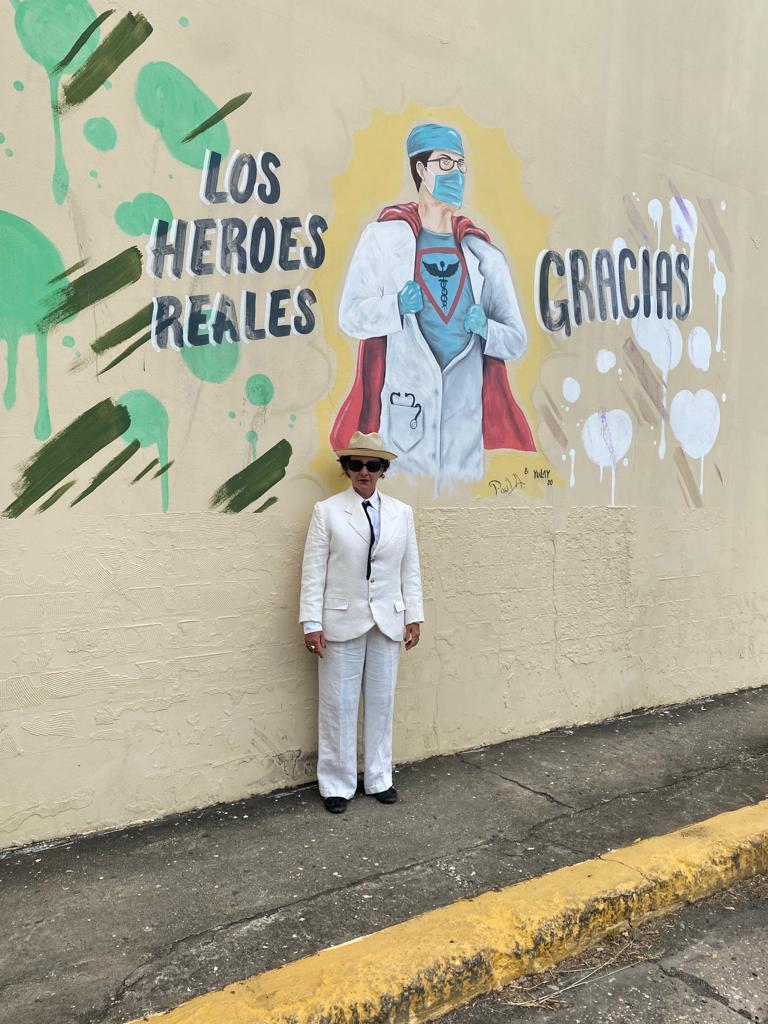
Los héroes reales (The Real Heroes). Arecibo, PR. April 2022. Copyright Teresa Hernández. All rights reserved.
Luisa Capetillo, cuchillo en boca was conceptualized as a live walk, with “stations” to stop and listen to Capetillo’s words, starting from Arecibo’s malecón, crossing the street where the Logia Tanamá and the abandoned Teatro Oliver are located, traversing the public square, and finalizing in front of the Instituto del Karso de Puerto Rico y el Caribe. The latter, alongside a Natural History Museum, will be housed in a closed school that the grassroots organization Ciudadanos del Karso has reclaimed. Capetillo was to be accompanied by two anonymous women with knives between their teeth –played by Teresa Peña Jordán and myself– and by the public who made it to the walk.
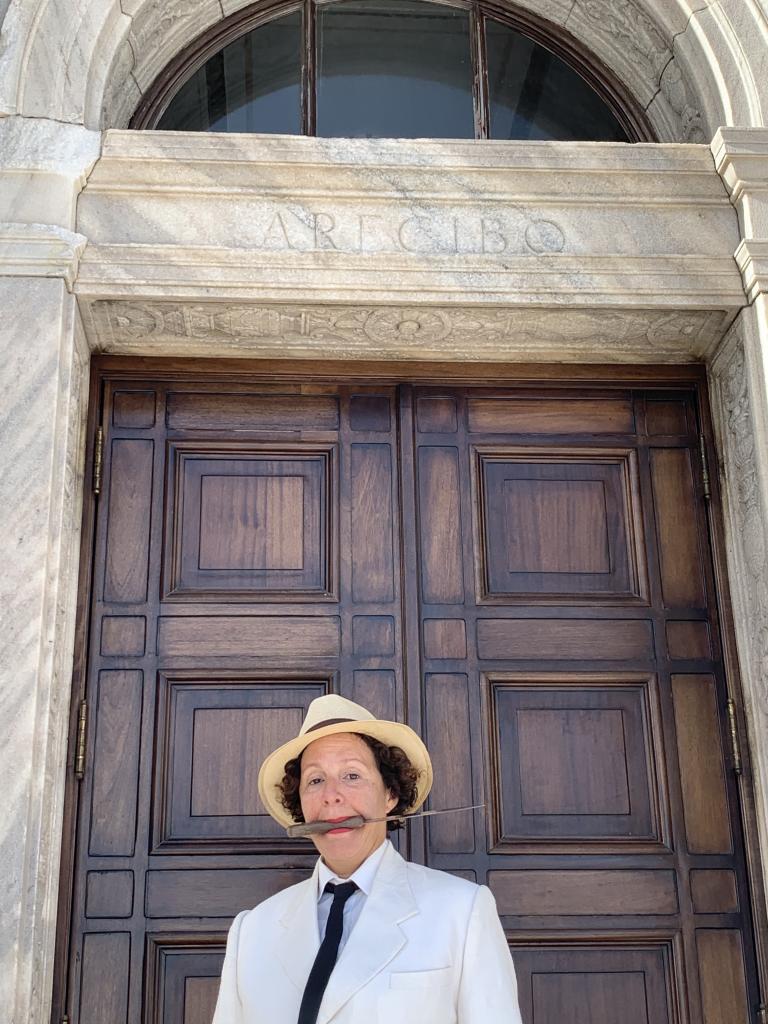
At the Arecibo Door. Capitolio, North Wing, San Juan, PR. Photo by Marisol Plard Narváez. July-August 2021. Copyright Teresa Hernández and Marisol Plard Narváez. All rights reserved.
On April 30, 2022, the day the piece was to be performed as part of the launch in Capetillo’s hometown of the new edition of Amor y anarquía: escritos de Luisa Capetillo (ed. Julio Ramos, Editora Educación Emergente, 2022), a looming threat of thunderous rain was upon us. Taking on the risks involved in pursuing the outdoor event was impossible. And so, the improvisatory quality of life in the colony took over. But this improvisation, as is the case with all rigorously artistic and creative improvisations, led to our collective forging, inside the ruinous building, of a new time and space. We kept the seeds intact: costume, action, image, word, the artist. But we translated them to another, apparently barren, land made of cement. The cold, hard, overbearing surfaces turned out to be full of spirits, yielding an uncanny, incontestable aliveness. By going back to Capetillo’s own words in a building “of before,” which is now a promise of an after, other time to come in a set of islands seemingly without future, Luisa Capetillo, cuchillo en boca became a compelling ritual, at once a cleansing and a prophecy. As we already have, we shall, again, overcome.
It never rained. The next morning, on the 1st of May, International Workers’ Day, an unprecedented tornado hit Arecibo’s waters. It was only natural...
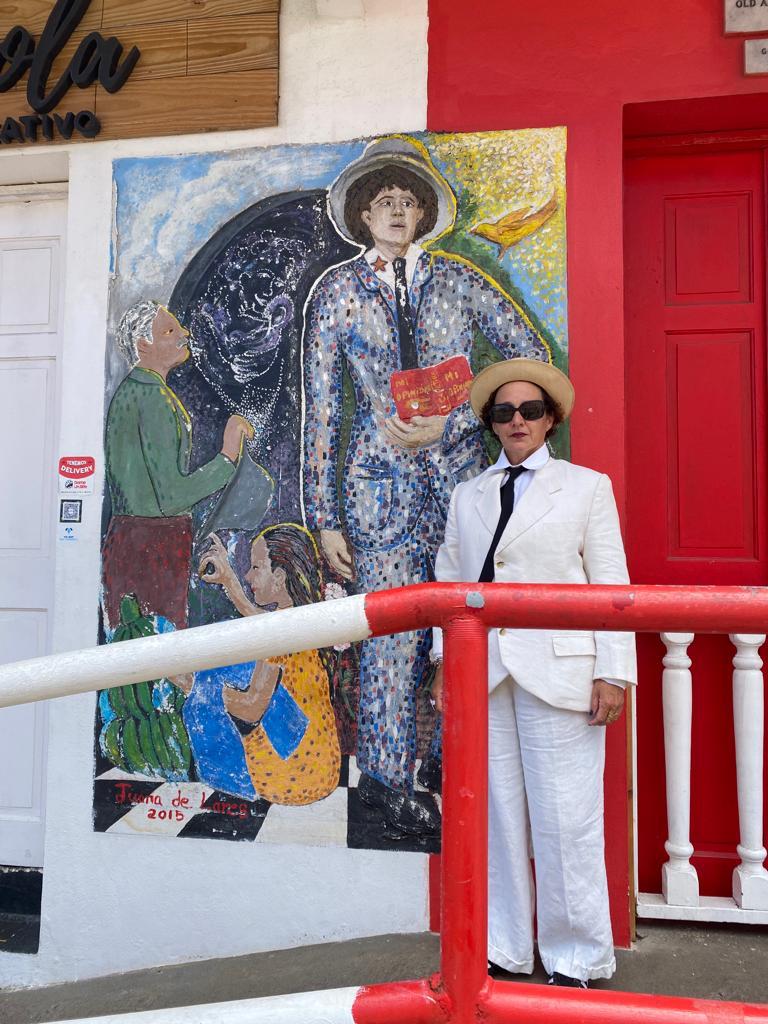
Luisa Squared. Arecibo, PR. April 2022. Copyright Teresa Hernández. All rights reserved.
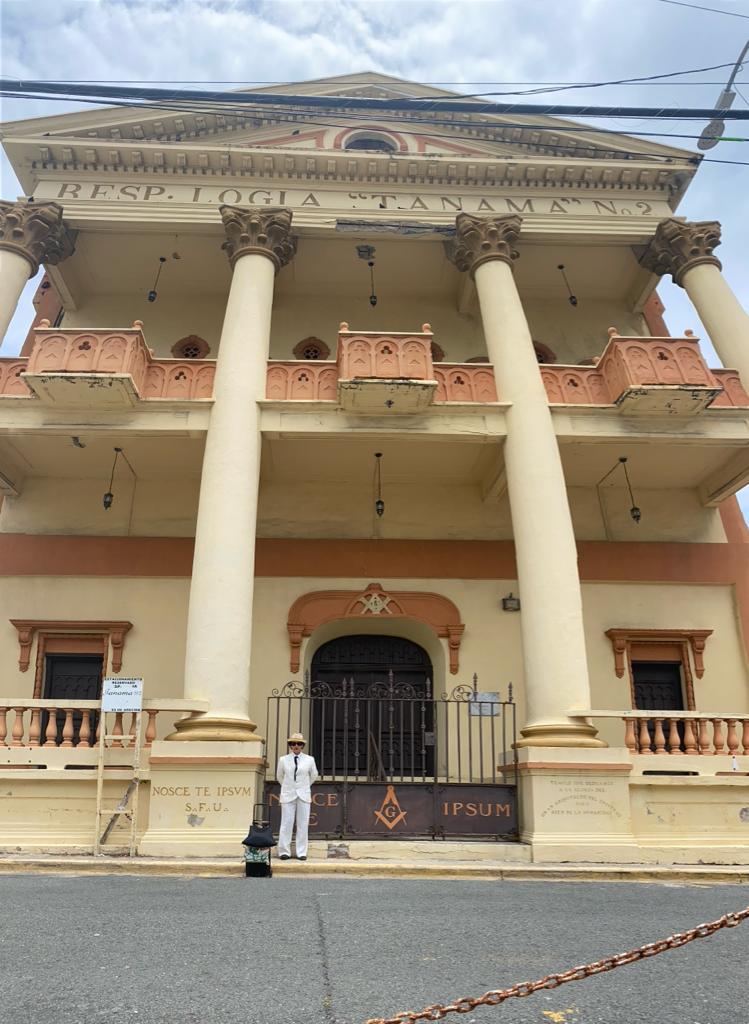
At the Tanamá Masonic Lodge. Arecibo, PR. April 2022. Copyright Teresa Hernández and Marisol Plard Naváez. All rights reserved.
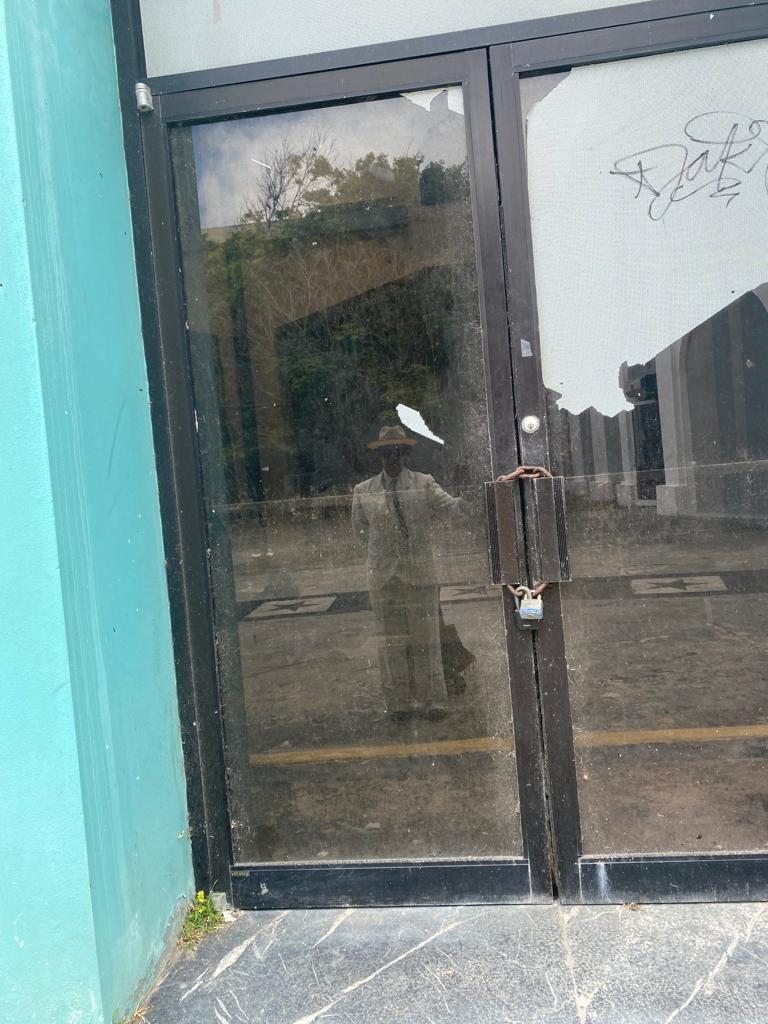
At the Abandoned Oliver Theater's Entrance. Arecibo, PR. Photo by Teresa Hernández. April 2022. Copyright Teresa Hernández. All rights reserved.
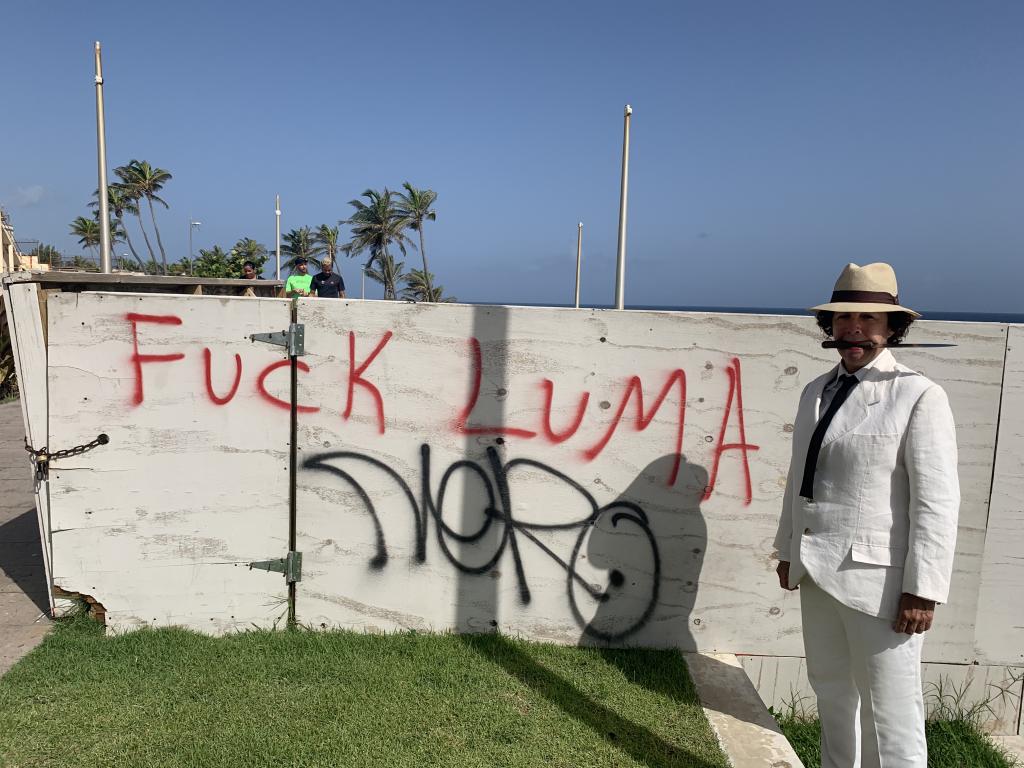
Fuck LUMA. San Juan, PR. Photo by Marisol Plard Narváez. July-August 2021. Copyright Teresa Hernández and Marisol Plard Narváez. All rights reserved.
Sobre Luisa Capetillo, cuchillo en boca: limpieza y profecía
Beatriz Llenín Figueroa
Un vestuario icónico: el pantalón y la chaqueta de hilo, la corbata angosta y el sombrero Panamá de Luisa Capetillo.
Una acción icónica: caminar.
Una imagen icónica: mujer con el cuchillo en la boca.
Una palabra icónica: la de Luisa Capetillo.
Y la artista escénica transdisciplinaria y puertorriqueña, Teresa Hernández.
Tales eran las semillas de la pieza performática, Luisa Capetillo, cuchillo en boca, que Teresa y yo habíamos compartido en exultante anticipación. Hemos sostenido, por algún tiempo ya, diálogos y colaboraciones en torno a inquietudes, pasiones, obsesiones, deseos, pavores comunes: los devenires puertorriqueños y caribeños en la era de la crisis climática, del alza en el nivel del mar, de las erosiones y desposesiones costeras (y de otros tipos); la violencia de género y el persistente abuso contra cuerpos, memorias y trabajos (re)productivos de mujeres y cuerpos feminizados; las cada vez más acorraladas posibilidades de producir y experimentar arte no comercial, y especialmente, artes vivas, en un país colonizado, en odiosa deuda neoliberal, explotado, en ruinas, arruinado por diseño. Como parte de su Bravatas –plataforma artística e investigativa en curso que emergió tras el huracán María en 2017–, Teresa ha estado produciendo trabajos transdisciplinarios (performance, teatro, danza, vídeo) concernidos con tales asuntos. En múltiples producciones de Bravatas, una mujer obrera con el cuchillo en la boca ha sido constante presencia –concepto que ella prefiere al de “personaje”–, y esta mujer obrera, entre otras acciones, camina. Sabemos de la importancia global, transhistórica, del caminar como acción política, como encarnación de una robusta oposición al poder. Más aún, en un pequeño país absurdamente sitiado por el carro como parte del “pacto” colonial que asegura una economía dependiente, de servicio y consumo –y ahora en bancarrota–, y en donde se registran a diario tasas alarmantes de violencia contra cuerpos de mujeres, feminizades y cuir, una mujer que camina a pecho abierto constituye, necesariamente, una aparición rebelde. Transferir el cuchillo de la boca de la obrera anónima a la de Luisa Capetillo, la anarquista, feminista, sindicalista, tabaquera, periodista, escritora, agitadora política, espiritista y revolucionaria general de comienzos de siglo XX, nacida en Arecibo, Puerto Rico, supuso, a la vez, que Bravatas se enraizara históricamente de manera más acentuada, y que Capetillo fuera traducida, su pensamiento y su acción actualizados, al presente, cien años después.
Luisa Capetillo, cuchillo en boca fue conceptualizada como una caminata en vivo, con “estaciones” para detenerse y escuchar las palabras de Capetillo, comenzando en el malecón de Arecibo y continuando a través de la calle en la que ubican la Logia Tanamá y el abandonado Teatro Oliver, cruzando la plaza pública, y finalizando frente al Instituto del Karso de Puerto Rico y el Caribe. Este último, junto a un Museo de Historia Natural, abrirán en una escuela cerrada que Ciudadanos del Karso, organización ecologista de base comunitaria y ciudadana, ha reclamado. Capetillo estaría acompañada por dos mujeres anónimas con cuchillos en boca –representadas por Teresa Peña Jordán y quien escribe– y por el público que llegara al evento.
El 30 de abril de 2022, día en que la pieza se escenificaría como parte del lanzamiento en la ciudad natal de Capetillo de la nueva edición de Amor y anarquía: escritos de Luisa Capetillo (ed. Julio Ramos, Editora Educación Emergente, 2022), planeaba sobre nosotres una acechante amenaza de lluvia copiosa. Con nuestros escasos recursos, resultaba imposible asumir los riesgos asociados, tanto para la artista como para el público, de insistir en un evento al aire libre. Y así, se impuso otra vez la improvisatoria cualidad de la vida en la colonia. Pero ésta, como es el caso con toda improvisación rigurosamente artística y creativa, nos condujo a la producción colectiva, al interior del edificio en ruinas, de un nuevo tiempo y espacio. Mantuvimos las semillas intactas: vestuario, acción, imagen, palabra, la artista. Pero las tradujimos a otra, aparentemente yerma, tierra hecha de cemento. Las superficies frías, duras, sofocantes resultaron rebosantes de espíritus, ofreciéndonos una viveza inquietante, indiscutible. Al retornar a las palabras de Capetillo en un edificio “de antes,” que es ahora una promesa de después, de un tiempo otro, por venir, en un conjunto de islas aparentemente sin futuro, Luisa Capetillo, cuchillo en boca se volvió un poderoso, cautivador ritual, a la vez limpieza y profecía. Del mismo modo en que ya hemos vencido –mirémonos aquí, ahora, estamos, seguimos–, venceremos, otra vez.
Ese día nunca llovió. En la mañana siguiente, el 1ro de mayo, Día Internacional de les Trabajadores, un tornado sin precedentes azotó aguas arecibeñas. Resultó lógico. Natural. De esperarse…